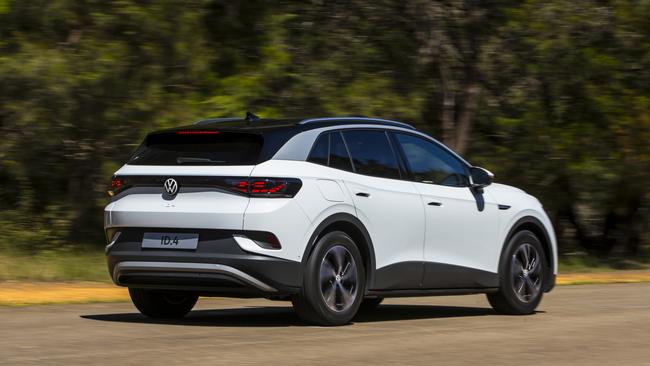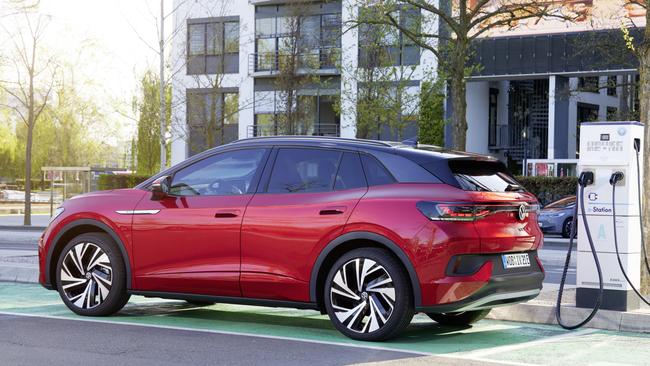Volkswagen’s ID.4 Tesla rival reaches Australia
No brand has lost more customers to Tesla than Volkswagen, but the carmaker plans to hit back at the electric car brand with a bold new machine.
New Cars
Don't miss out on the headlines from New Cars. Followed categories will be added to My News.
Australia was at the back of the queue when Volkswagen released its first electric cars.
The brand’s battery-powered machines will have been on sale in Europe for three long years by the time they reach local customers, a situation frustrated representatives attribute to a lack of green car incentives or emissions-based taxes here.
Customers have responded by flocking to Tesla.

Data released by the Electric Vehicle Council suggests no brand has lost more business to the American concern than Volkswagen, with about one in 10 local Tesla customers trading in a Volkswagen.
The German giant will hit back with three electric cars in the Golf-sized ID.3 hatch, the ID.4 mid-size SUV and a stylish coupe-like crossover named ID.5.
The most important model is the ID.4, a car that will enter the booming medium SUV segment as a direct rival to the Tesla Model Y.
VW Australia’s director of passenger vehicles, Michal Szaniecki, says the electric SUV represents “the most sizeable opportunity for Volkswagen Australia in countless years”.
“The clear target is to have the ID.4, along with the ID.5, in Australian driveways by late 2023.”
While local specifications are still to be confirmed, VW says the ID.4 will be priced close to the petrol-powered Tiguan 162 TSI R-Line that starts from $62,500 drive-away. That’s a good $10,000 less than the equivalent Tesla, though the VW falls short in a few key areas.
Built on a dedicated electric vehicle platform, the conservatively styled ID.4 has the long wheelbase, short overhangs and generous cabin space found in modern electric cars.
A flat-floored interior feels spacious, with more rear head and legroom than you will find in most cars this size.

There’s little wow factor to a dark cabin with a compact 5.3-inch digital driver display accompanied by a 12-inch wide-screen infotainment unit in the middle of the dash. The workable system misses out on crowd favourites such as YouTube, Netflix and video games found in the Tesla. As is the case in the latest Golf, cabin plastics have a slightly cheaper feel than loyal customers might expect.
A powered tailgate opens to reveal a decent 543 litres of boot space but unlike many modern electric cars, there is no storage space under the front bonnet.

Volkswagen offered brief test drives on a short test track of two models with slightly confusing names in the ID.4 “Pro”, which is aimed toward private buyers, and the “Pure”, which is pitched at professionals driving for fleets including police and ambulance services.
The better-equipped ID.4 Pro has a rear-mounted electric motor sending 150kW and 310Nm to the back tyres. Capable of 100km/h in 8.5 seconds – perfectly adequate for a family wagon, but underwhelming for an electric car – the Pro has an 82kWh battery with an impressive 522 kilometres of claimed range.

ID.4 Pure models make do with a less powerful 125kW and 310Nm motor, along with a smaller 55kWh battery delivering just 345 kilometres of range. The standard car accepts charge at a maximum rate of 110kW, while the Pro can handle 125kW of electricity flow. Both are slower than class leaders from Hyundai, Kia and Tesla. Charging from zero to 80 per cent takes 26 minutes on the standard ID.4, or 33 minutes for the Pro.

The ID.4’s rear-drive layout allows front wheels unencumbered by drive shafts to steer at more aggressive angles than conventional cars, returning a significantly tighter turning circle than VW’s Golf, a neat trick considering the ID. 4 is a bigger car.

It also means the steering wheel doesn’t twist in your hands under full-throttle acceleration, returning a more refined experience than front-drive rivals.
Sensibly geared steering and a measured response from the brake pedal join suspension that has the sort of pitch and roll we’ve come to expect from heavy electric cars but a lack of bumps on the low-speed test track made it hard to give an accurate account of its bump absorption and cornering in the real world.
Our early impression is that the Volkswagen ID. 4 is a solid, but not spectacular, entry to the world of electric cars. One that will be welcomed by the VW faithful.

VOLKSWAGEN ID.4 PRO
PRICE About $62,500 drive-away
MOTOR Electric motor, 150KW and 310Nm
WARRANTY 5-year/u’ltd km
SAFETY Seven airbags, auto emergency braking, active cruise control, blind-spot monitoring, rear cross-traffic alert, lane-keep assist
RANGE 522km
CARGO 543 litres
SPARE Repair kit


